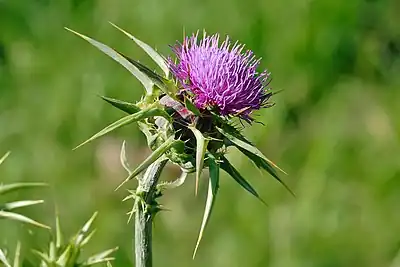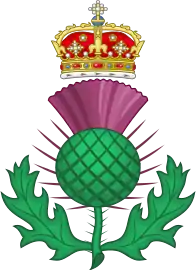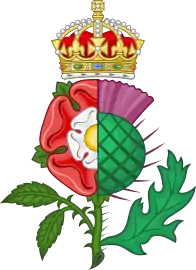

Thistle is the common name of a group of flowering plants characterised by leaves with sharp prickles on the margins, mostly in the family Asteraceae. Prickles can also occur all over the plant – on the stem and on the flat parts of the leaves. These prickles are an adaptation that protects the plant from being eaten by herbivores. Typically, an involucre with a clasping shape similar to a cup or urn subtends each of a thistle's flower heads. The typically feathery pappus of a ripe thistle flower is known as thistle-down.[1]
The comparative amount of spininess varies dramatically by species. For example, Cirsium heterophyllum has minimal spininess while Cirsium spinosissimum is the opposite.[2] Typically, species adapted to dry environments have greater spininess.
The term thistle is sometimes taken to mean precisely those plants in the tribe Cardueae (synonym: Cynareae),[3] especially the genera Carduus, Cirsium, and Onopordum.[4] However, plants outside this tribe are sometimes called thistles.
Biennial thistles are particularly noteworthy for their high wildlife value, producing such things as copious floral resources for pollinators, nourishing seeds for birds like the goldfinch, foliage for butterfly larvae, and down for the lining of birds' nests.[5][6][7]
A thistle is the floral emblem of Scotland and Lorraine, as well as the emblem of the Encyclopædia Britannica.
Taxonomy



Genera in the Asteraceae with the word thistle often used in their common names include:
- Carduus – musk thistle and others
- Carduinae – burdock root
- Carlina – carline thistle
- Carthamus – distaff thistle
 Milk Thistle is shown as an ingredient in making an anesthetic potion to capture a wolf in RRR (telugu) 2022 movie
Milk Thistle is shown as an ingredient in making an anesthetic potion to capture a wolf in RRR (telugu) 2022 movie - Centaurea – star thistle
- Cicerbita – sow thistle
- Cirsium – common thistle, field thistle and others
- Cnicus – blessed thistle
- Cynara – artichoke, cardoon
- Echinops – globe thistle
- Notobasis – Syrian thistle
- Onopordum – cotton thistle, also known as Scots or Scotch thistle
- Scolymus – golden thistle or oyster thistle
- Silybum – milk thistle
- Sonchus – sow thistle
Plants in families other than Asteraceae which are sometimes called thistle include:
- Kali – Russian thistle, Tartar thistle, or tumbleweed, plants formerly classified in the genus Salsola (family Chenopodiaceae)
- Argemone mexicana – flowering thistle, purple prickly poppy (family Papaveraceae)
- Eryngium – certain species include the word thistle, such as beethistle, E. articulatum (family Apiaceae)
- Dipsacus fullonum – German names include Hausdistel, Kartendisteln, Roddistel, Sprotdistel and Weberdistel (family Caprifoliaceae)
Ecology

Thistle flowers are the favourite nectar sources of the pearl-bordered fritillary, small pearl-bordered fritillary, high brown fritillary, and dark green fritillary butterflies.[8] Thistles and thistle-seed feeders provide important sustenance for goldfinches and are strongly favored by many butterflies besides fritillaries such as the monarch, skippers, and the various types of tiger swallowtail. Hummingbirds will feed on the flowers of the biennial species, which feature large flowers, as compared with the perennial Canada thistle.
Some thistles, for example Cirsium vulgare, native to Eurasia, have been widely introduced outside their native range.[9] Control measures include Trichosirocalus weevils. A problem with this approach, at least in North America, is that the introduced weevils may affect native thistles at least as much as the desired targets.[10]
Thistles have been said to be very important nectar sources for pollinators. Some ecological organizations, such as the Xerces Society, have attempted to raise awareness of their benefits, to counteract the general agricultural and home garden labeling of thistles as unwanted weeds. The monarch butterfly, Danaus plexippus for instance, was highlighted as traditionally relying upon taller large-flowered thistle species such as Tall thistle, Cirsium altissimum, for its migration.[6] Although such organizations focus on the benefits of native thistles, certain non-native thistles, such as Cirsium vulgare in North America, may provide similar benefits to wildlife.[7]
Some prairie and wildflower seed production companies supply bulk seed for native North American thistle species, for wildlife habitat restoration, although availability tends to be low. Thistles are particularly valued by bumblebees for their high nectar production. Cirsium vulgare ranked in the top 10 for nectar production in a UK plants survey conducted by the AgriLand project which is supported by the UK Insect Pollinators Initiative.[7] Bull thistle was a top producer of nectar sugar in another study in Britain, ranked third with a production per floral unit of (2323 ± 418μg).[5]
Uses
Maud Grieve recorded that Pliny and medieval writers had thought it could return hair to bald heads and that in the early modern period it had been believed to be a remedy for headaches, plague, cancer sores, vertigo, and jaundice.[11][12]
Cuisine
In Portugal's Beira region, thistle flowers are used in cheese making, as a source of enzymes to coagulate the milk. "Serra da Estrela" is not only the name of a mountain chain in this country, "Serra da Estrela" is also the name of one of the most appreciated cheeses made from sheep's milk.[13]
Economic significance
Thistles, even if one restricts the term to members of the Asteraceae, are too varied a group for generalisation. Many are troublesome weeds, including some invasive species of Cirsium, Carduus, Silybum and Onopordum.[14] Typical adverse effects are competition with crops and interference with grazing in pastures, where dense growths of spiny vegetation suppress forage plants and repel grazing animals from eating either the thistle plants or neighbouring forage. Some species, although not intensely poisonous, affect the health of animals that swallow more than small amounts of the material.[15][16]
The genus Cynara includes commercially important species of artichoke and some species regarded as major weeds are commercial sources of vegetable rennet used in commercial cheese making.[17] Similarly, some species of Silybum that occur as weeds are cultivated for seeds that yield vegetable oil and pharmaceutical compounds such as Silibinin.[18][19][20]
Other thistles that nominally are weeds are important honey plants, both as bee fodder in general, and as sources of luxury monofloral honey products.[14][21][22]
Culture
Heraldry
Scottish thistle
The thistle has been the national emblem of Scotland since the reign of King Alexander III (1249–1286). According to legend, an invading Norse army was attempting to sneak up at night upon a Scottish army's encampment. During this operation, one barefoot Norseman had the misfortune to step upon a thistle, causing him to cry out in pain, thus alerting Scots to the presence of the Norse invaders. Some sources suggest the specific occasion was the 1263 Battle of Largs, which marked the beginning of the departure of King Haakon IV (Haakon the Elder) of Norway who, having control of the Northern Isles and Hebrides, had harried the coast of the Kingdom of Scotland for some years.[23]


As a Scottish symbol and national emblem, the thistle was used on silver coins first issued by King James III in 1474.[24][25] In 1536, the bawbee, a sixpence in the pound Scots, was issued for the first time under King James V; it showed a crowned thistle. Thistles continued to appear regularly on Scottish and later British coinage until 2008, when a 5p coin design showing "The Badge of Scotland, a thistle royally crowned" ceased to be minted, though it remains in circulation. The Most Ancient and Most Noble Order of the Thistle, the highest and oldest chivalric order of Scotland, has thistles on its insignia and a chapel in St Giles's Kirk, Edinburgh, dubbed the Thistle Chapel. The thistle is the main charge of the regimental badge of the Scots Guards, the oldest regiment in the British Army.
Both the Order of the Thistle and the Scots Guards use the motto Nemo me impune lacessit, the motto of the House of Stuart and referring to the thistle's prickly nature. Pound coins with this motto and a thistle were minted in 1984, 1989, and 2014. The combination of thistle and motto first appeared on the bawbee issued by King Charles II. In 1826, the grant of arms to the new National Bank of Scotland stipulates that the shield be surrounded by thistles and "thistle" is used as the name of several Scottish football clubs. Since 1960, a stylised thistle, also representing the Scottish Saltire, has been the logo of the Scottish National Party.
Since 2013, a different stylised thistle, crowned with the Scottish crown, has been the emblem of Police Scotland, and had long featured in the arms of seven of the eight pre-2013 Scottish police services and constabularies, the sole exception being the Northern Constabulary. As part of the arms of the University of Edinburgh, the thistle appears together with a saltire on one of the escutcheons of the Mercat Cross in Edinburgh. The coat of arms and crest of Nova Scotia ("New Scotland"), briefly Scotland's colony, have since the 17th century featured thistles. Following his ascent to the English throne, King James VI of Scotland & I of England used a badge consisting of a Tudor rose "dimidiated" with a Scottish thistle and surmounted by a royal crown.[26]
As the floral emblem of Scotland it appears in the Royal Arms of the United Kingdom thereafter, and was included in the heraldry of various British institutions, such as the Badge of the Supreme Court of the United Kingdom alongside the Tudor rose, Northern Irish flax, and Welsh leek. This floral combination appears on the present issues of the one pound coin. Beside the Tudor rose and Irish shamrock the thistle appears on the badge of the Yeomen of the Guard and the arms of the Canada Company. Issues of the historical florin showed the same flora, later including a leek.
The thistle is also used to symbolise connection with Scotland overseas. For example, in Canada, it is one of the four floral emblems on the flag of Montreal; in the US, Carnegie Mellon University features the thistle in its crest in honour of the Scottish heritage of its founder, Andrew Carnegie, and Annapolis, Maryland features the thistle in its flag and seal. The thistle is also the emblem of the Encyclopædia Britannica (which originated in Edinburgh, Scotland) and Jardine Matheson Holdings Limited (as the company was founded by two Scots).
Which species of thistle is referred to in the original legend is disputed. Popular modern usage favours cotton thistle (Onopordum acanthium), perhaps because of its more imposing appearance, though it is not native and unlikely to have occurred in Scotland in mediaeval times. The spear thistle (Cirsium vulgare), an abundant native species in Scotland, is a more likely candidate.[27][28] Other species, including dwarf thistle (Cirsium acaule), musk thistle (Carduus nutans), and melancholy thistle (Cirsium heterophyllum) have also been suggested.[29]
 Scottish thistle as a Heraldic badge
Scottish thistle as a Heraldic badge Badge of the Yeomen of the Guard
Badge of the Yeomen of the Guard Badge of James VI & I. Thistle dimidiated with a Tudor rose
Badge of James VI & I. Thistle dimidiated with a Tudor rose
Thistle of Lorraine

The thistle, and more precisely Onopordum acanthium, is one of the symbols of Lorraine, together with its coat of arms which displays three avalerions, and the Cross of Lorraine.
Lorraine is a region located in northeastern France, along the border with Luxembourg and Germany. Before the French Revolution, a large part of the region formed the Duchy of Lorraine. In the Middle Ages, the thistle was an emblem of the Virgin Mary because its white sap would bring to mind the milk falling from the breast of the Mother of God. It was later adopted as a personal symbol by René of Anjou, together with the Cross of Lorraine, then known as the Cross of Anjou. It seems through his book Livre du cuer d'amours espris that the Duke chose the thistle as his emblem not only because it was a Christian symbol, but also because he associated it with physical love.[30]
The thistle and the cross were used again by his grandson, René II, Duke of Lorraine, who introduced them in the region. The two symbols became hugely popular among the local people during the Battle of Nancy in 1477, during which the Lorrain army defeated Burgundy. The Duke's motto was "Qui s'y frotte s'y pique", meaning "who touches it, pricks oneself", with a similar idea to the Scottish motto "Nemo me impune lacessit". Nowadays the thistle is still the official symbol of the city of Nancy, as well as the emblem of the AS Nancy football team, and the Lorraine Regional Natural Park.[31][32]
Place names
Carduus is the Latin term for a thistle (hence cardoon, chardon in French), and Cardonnacum is a Late Latin word for a place with thistles. This is believed to be the origin of name of the Burgundy village of Chardonnay, Saône-et-Loire, which in turn is thought to be the home of the famous Chardonnay grape variety.
References
- ↑ "Definition of THISTLEDOWN". www.merriam-webster.com. Retrieved 28 September 2023.
- ↑ "Melancholy Thistle". NatureGate. Retrieved 27 November 2019.
- ↑ "Cardueae". Tree of Life webproject. Retrieved 30 October 2012.
- ↑ "Thistle". Merriam-Webster's online dictionary. Retrieved 30 November 2007.
- 1 2 Hicks, DM; Ouvrard, P; Baldock, KCR (2016). "Food for Pollinators: Quantifying the Nectar and Pollen Resources of Urban Flower Meadows". PLOS ONE. 11 (6): e0158117. Bibcode:2016PLoSO..1158117H. doi:10.1371/journal.pone.0158117. PMC 4920406. PMID 27341588.
- 1 2 Eckberg, James; Lee-Mäder, Eric; Hopwood, Jennifer; Foltz Jordan, Sarah; Borders, Brianna (2017). "Native Thistles: A Conservation Practitioner's Guide". The Xerces Society. Retrieved 27 August 2018.
- 1 2 3 "Which flowers are the best source of nectar?". Conservation Grade. 15 October 2014. Archived from the original on 14 December 2019. Retrieved 18 October 2017.
- ↑ Bracken for Butterflies Archived 3 October 2008 at the Wayback Machine leaflet c0853 by Butterfly Conservation, January 2005
- ↑ Cirsium vulgare (Savi) Ten., Asteraceae Archived 19 December 2009 at the Wayback Machine, Pacific Island Ecosystems at Risk (PIER)
- ↑ Takahashi, Masaru; Louda, SM; Miller, TE; O'Brien, CW (2009). "Occurrence of Trichosirocalus horridus (Coleoptera: Curculionidae) on Native Cirsium altissimum Versus Exotic C. Vulgare in North American Tallgrass Prairie". Environmental Entomology. 38 (3): 731–40. doi:10.1603/022.038.0325. PMID 19508782. S2CID 55487.
- ↑ Grieve, Maud. "A Modern Herbal". Retrieved 3 June 2011.
- ↑ Pliny the Elder; John Bostock (trans.) (1855). "20.99". The Natural History. London: Taylor and Francis.
- ↑ Anita (21 July 2014). "Portugal's "thistle cheeses"". Anita's Feast. Retrieved 30 November 2020.
- 1 2 Rakesh Kumar Gupta; Wim Reybroeck; Johan W. Veen; Anuradha Gupta (18 September 2014). Beekeeping for Poverty Alleviation and Livelihood Security. Springer. pp. 47–. ISBN 978-94-017-9199-1.
- ↑ W. T. Parsons; Eric George Cuthbertson (2001). Noxious Weeds of Australia. Csiro Publishing. pp. 189–. ISBN 978-0-643-06514-7.
- ↑ Watt, John Mitchell; Breyer-Brandwijk, Maria Gerdina: The Medicinal and Poisonous Plants of Southern and Eastern Africa 2nd ed Pub. E & S Livingstone 1962
- ↑ Vioque, Montserrat; Gómez, Rafael; Sánchez, Emilia; Mata, Carmen; Tejada, Luis; Fernández-Salguero, José (2000). "Chemical and Microbiological Characteristics of Ewes' Milk Cheese Manufactured with Extracts from Flowers of Cynara cardunculus and Cynara humilis as Coagulants". Journal of Agricultural and Food Chemistry. 48 (2): 451–456. doi:10.1021/jf990326v. PMID 10691655.
- ↑ Pepping, J (June 1999). "Milk thistle: Silybum marianum". Am J Health Syst Pharm. 56 (12): 1195–7. doi:10.1093/ajhp/56.12.1195. PMID 10484652.
- ↑ Laekeman, G; De Coster, S; De Meyer, K (2003). "[St. Mary's Thistle: an overview]". J Pharm Belg. 58 (1): 28–31. PMID 12722542.
- ↑ Alemardan, Ali; Karkanis, Anestis; Salehi, Reza (2013). "Breeding Objectives and Selection Criteria for Milk Thistle (Silybum marianum (L.) Gaertn.) Improvement". Not Bot Horti Agrobo. 41 (2): 340–347. doi:10.15835/nbha4129298.
- ↑ C. Marina Marchese; Kim Flottum (4 June 2013). The Honey Connoisseur: Selecting, Tasting, and Pairing Honey, With a Guide to More Than 30 Varietals. Black Dog & Leventhal Publishers. pp. 206–. ISBN 978-1-60376-332-5.
- ↑ Technical Bulletin. The Department. 1940. pp. 5–.
- ↑ Webmaster, John Duncan (4 April 2009). "Scots History Online". UK: Scots History Online. Archived from the original on 2 November 2011. Retrieved 14 January 2013.
- ↑ "Chapter 18". A Complete Guide to Heraldry. T.C. & E.C. Jack. 1909.
- ↑ "University of Glasgow - The Hunterian - Visit - Exhibitions - Exhibition Programme - Scotland's Own Coinage". www.gla.ac.uk. Retrieved 19 February 2020.
- ↑ Fox-Davies, A.C. (1907). Heraldic Badges. London: John Lane. p. 117. OCLC 4897294 – via Internet Archive.
- ↑ "Flowers of Scotland: Thistle". Twocrows.co.uk. Retrieved 14 January 2013.
- ↑ "Why is the THISTLE a Scottish national symbol?". Ormiston.com. Retrieved 14 January 2013.
- ↑ "Scotland Fact File: The Thistle". Visitscotland.com. Retrieved 14 January 2013.
- ↑ Christian Pfister (1908). Histoire de Nancy. Vol. 1. Berger-Levrault. p. 554.
- ↑ "Le chardon". Tela Botanica. Archived from the original on 12 February 2017. Retrieved 11 February 2017.
- ↑ "Origine du blason de Nancy". Nancy WebTV. Retrieved 11 February 2017.
External links
![]() Texts on Wikisource:
Texts on Wikisource:
- "Lily-Bell and Thistle-down" (a fairy tale) in Flower Fables by Louisa May Alcott (1855)
- Allen, Charles Grant Blairfindie (November 1886). "Thistles". Popular Science Monthly. Vol. 30.
- "Thistle". Encyclopædia Britannica (11th ed.). 1911.
- "Thistle-Down" (a poem) in Flint and Feather by E. Pauline Johnson (1912)